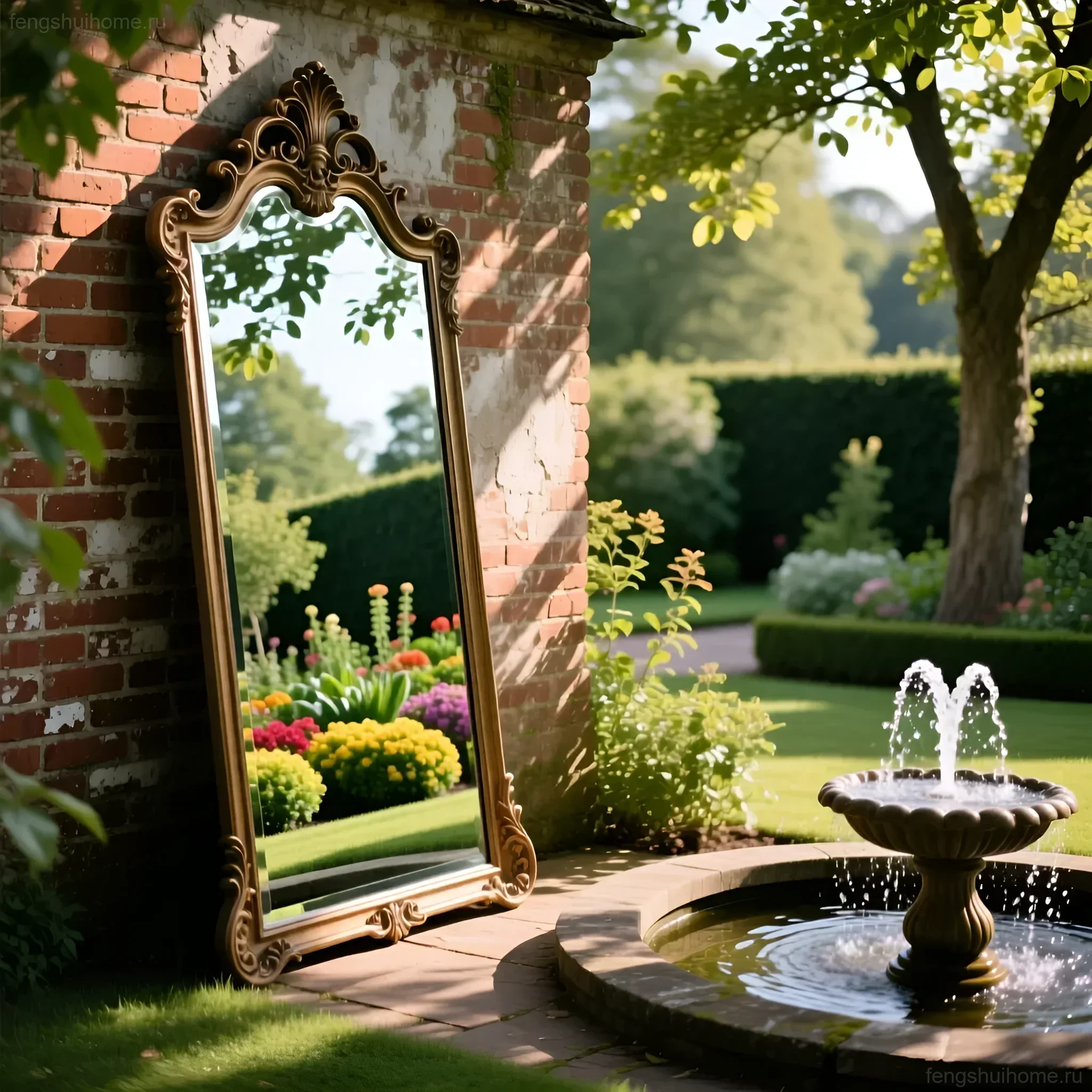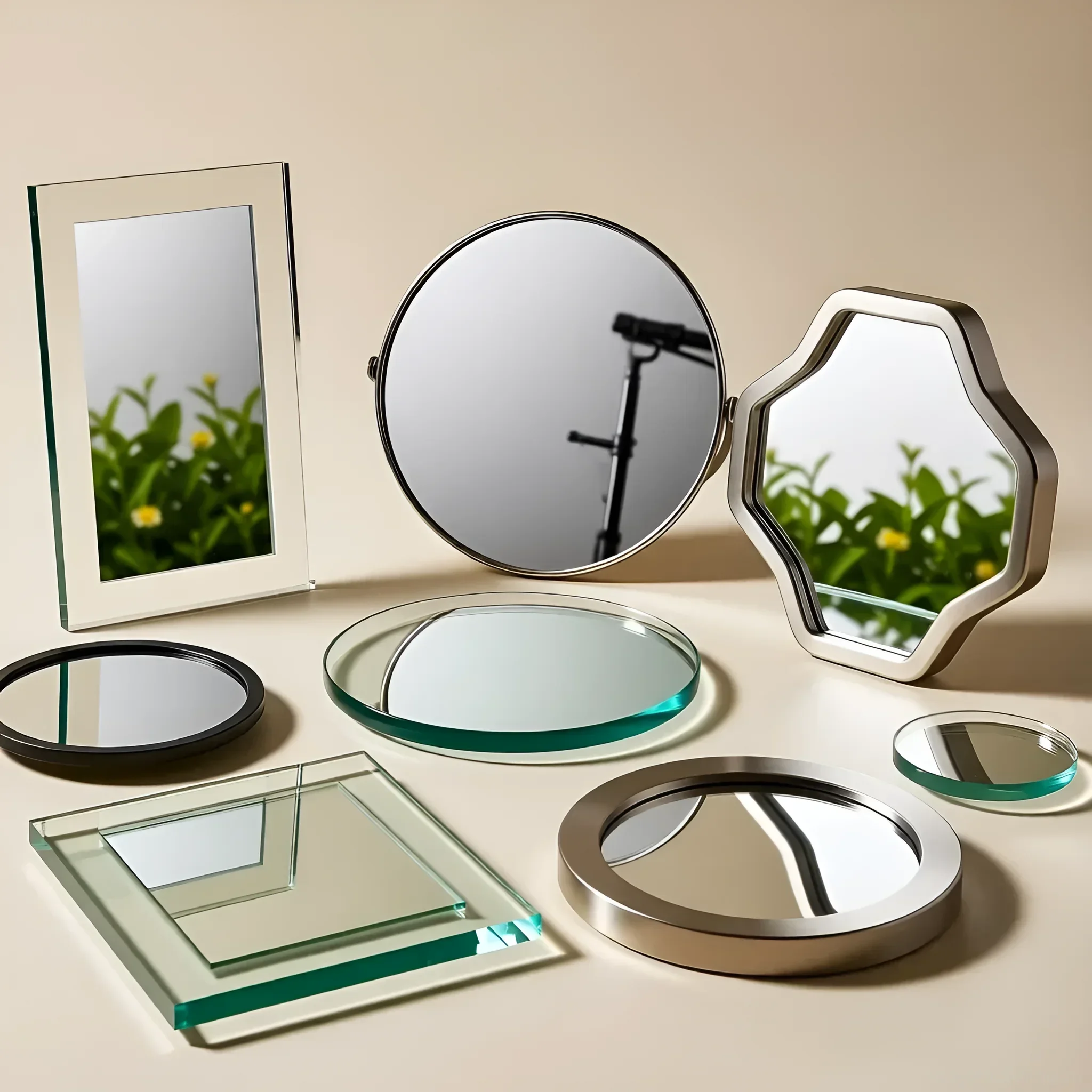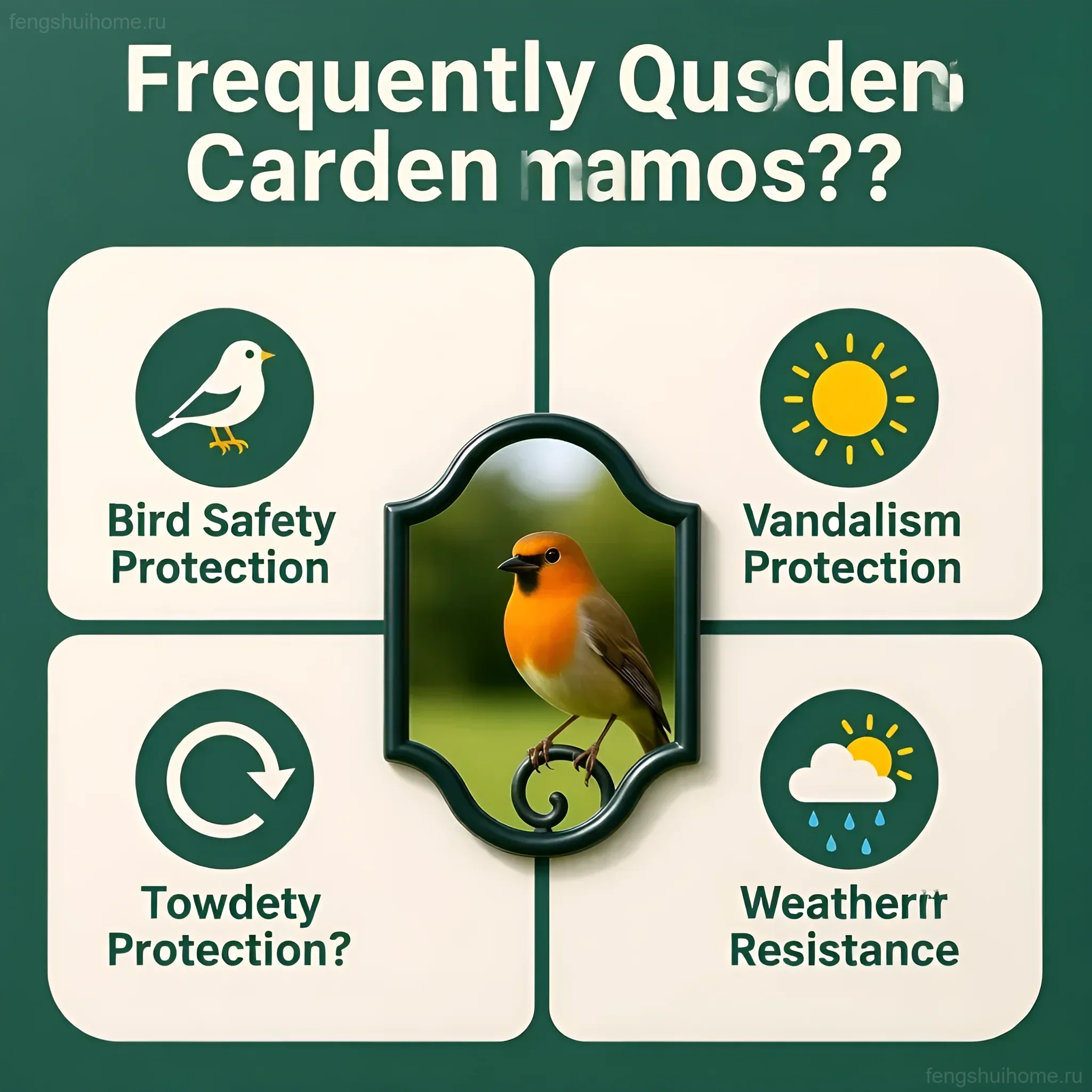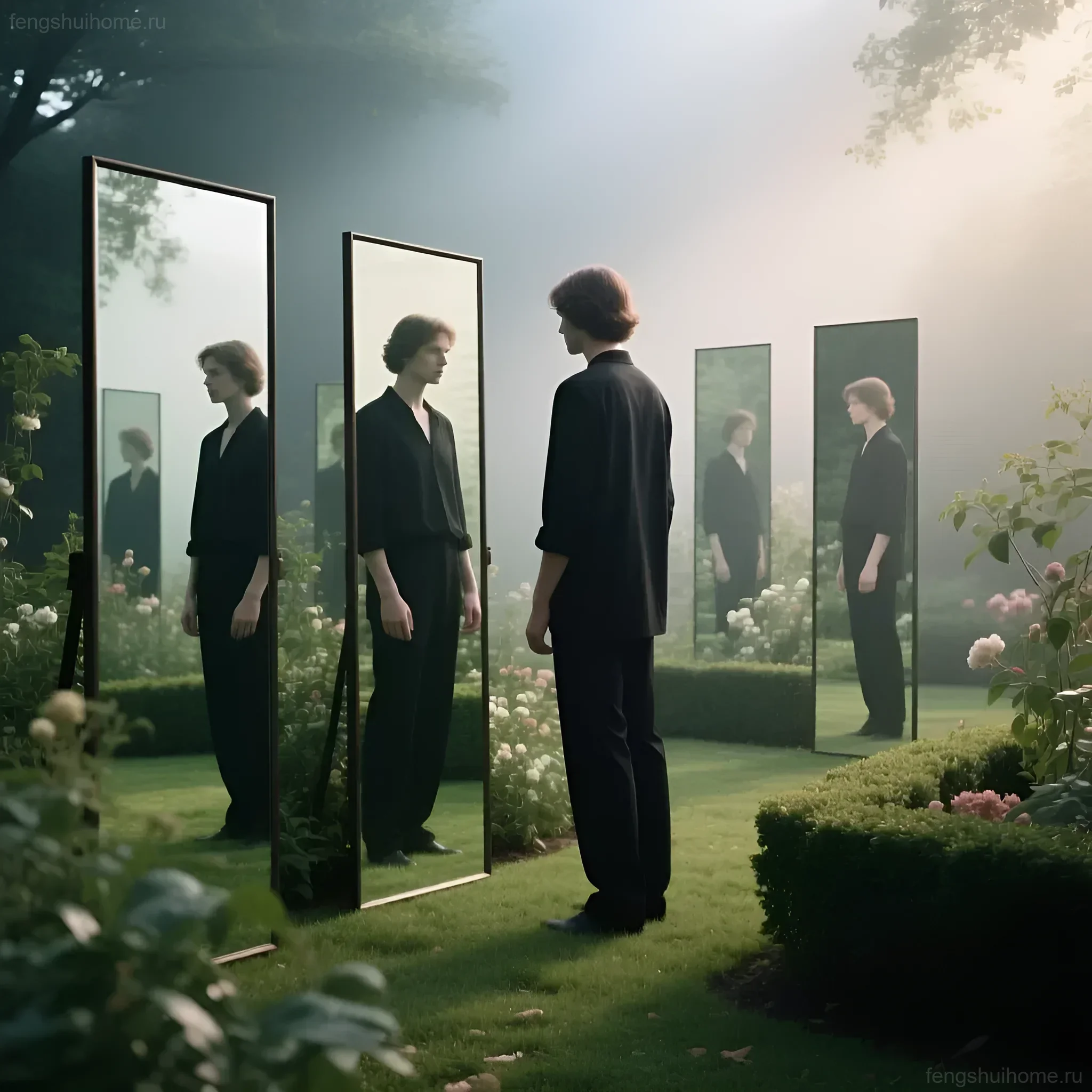A mirror is not just an interior item; in the skilled hands of a landscape designer, it transforms into a powerful tool for visual transformation. Using reflective surfaces in the garden allows not only to “push” the boundaries of the plot but also to significantly enhance the decorative effect of existing elements: flowers, sculptures, and water features.
Mirrors in Landscape Design: The Magic of Reflections and Space Expansion

The main function of a mirror in the garden is to create an illusion. When a reflective surface is installed correctly, the eye perceives the reflection as a continuation of the existing space, which is critically important for small or narrow plots.
Advantages of Using Mirrors in Landscape Design:
- Visual Depth Enhancement: A mirror placed at the end of a narrow path or on the wall of a courtyard creates the impression that there is another “secret” garden beyond it.
- Illumination Boost: In dark, shaded corners of the garden, mirrors can reflect available light, making these areas brighter and more inviting.
- Duplicating Focal Points: A beautiful plant, sculpture, or water feature reflected in a mirror is visually doubled, enhancing its impact.
- Camouflage: Mirrors are excellent at hiding unsightly elements such as utility structures, old fences, or blank walls, diverting attention to their reflections.
- “Window” Effect: Mirrors framed like window frames create the impression that you are looking into a neighboring, perfectly manicured garden.
It is important to understand that a garden mirror is not just an interior item. It must be resistant to moisture, temperature fluctuations, and direct sunlight.
Where to Best Place Mirrors in the Garden: Choosing the Ideal Spot

Choosing the location is the most critical step. An error in placement can lead to the mirror reflecting not beauty, but, for example, a shed or a trash bin. The goal is to reflect only the best and create a sense of mystery.
Ideal Zones for Placement:
1. Narrow Passages and Corridors:
- Install a mirror on the end wall of a pergola or arch. This will instantly lengthen the structure.
- Place the mirror at eye level or slightly lower to reflect the path and the lower tier of plants.
2. Small Patios and Courtyards:
- Use large mirror panels designed as false windows on blank walls. This is critically important for urban gardens where walls often create a sense of confinement.
3. Dark and Shaded Corners:
- Position the mirror at an angle so it “catches” sunlight filtering through tree canopies and directs it into the shade.
4. In the Depths of Dense Plantings:
- Small, partially hidden mirrors tucked among the foliage create the effect of “shimmering windows” or suggest a path that actually ends.
The Rule of the Reflected Object: Always check what exactly will be visible in the reflection. Ideally, it should be: beautiful flowers, the sky, lush greenery, or water features. Avoid reflecting empty walls, a gray sky, or utility structures.
Types of Garden Mirrors: From Decorative to Functional

The choice of material directly affects the durability and safety of the structure. Regular interior mirrors are not suitable for outdoor use.
Materials and Safety
1. Tempered Glass (Garden Mirror):
- Pros: Excellent reflection clarity, high scratch resistance.
- Cons: Expensive, heavy, requires professional installation. If broken, it shatters into smaller, less sharp pieces.
2. Acrylic (Plexiglass) Mirrors:
- Pros: Lightweight, extremely durable, shatterproof, safe. Ideal for areas where children or pets play.
- Cons: Reflection can be slightly distorted (especially over large areas), less scratch-resistant than glass.
3. Mirrors with Protective Coating (Amalgam):
For outdoor use, it is necessary to use mirrors with amalgam protected by a special waterproof coating (often silver or aluminum plating covered with a layer of paint or polymer). This will prevent “blooming” and peeling of the reflective layer due to moisture and condensation.
Stylistic Solutions
- Mirror Windows: The most popular type. They have a frame that mimics a window sash (muntins). They create the effect of an architectural extension of the house.
- Aged (Antique) Mirrors: Specially treated mirrors with a patina effect or partial darkening. Ideal for Provence or rustic style gardens.
- Hidden Mirrors: Small round or oval mirrors integrated into pergolas or walls, as if they are part of a decorative lattice.
Mirrors and Water Features: Creating an Illusion of Infinity

The combination of a mirror surface and water is a classic design technique that enhances the feeling of freshness, coolness, and tranquility.
How to Use Mirrors with Water:
1. Doubling a Waterfall:
If your garden has a small waterfall or cascade, place a vertical mirror on the wall directly behind it or to the side. The mirror will create the impression that the waterfall is twice as wide or deep as it actually is. Important: the mirror must be reliably protected from direct splashes to avoid constant streaks.
2. Illusion of a “Second” Pond:
Install a mirror panel on the ground, flush with the edge of an existing pond. Use low-lying stones or edging to conceal the transition. This way, the pond will appear twice as long.
3. Mirror Streams:
Instead of water in a dry stream bed, you can use narrow strips of acrylic mirror laid among pebbles and stones. When light hits them, they will imitate the sparkle of water without requiring a complex circulation system.
4. Reflecting a Fountain:
Place a fountain in front of a mirror mounted on a wall. The effect of moving water and reflections will be amplified, and the symmetry will create a sense of luxury and balance.
Mirrors in Landscape Design: Practical Tips for Installation and Care

The longevity of a garden mirror depends on the quality of installation and proper care. Incorrect installation can be dangerous and quickly render the mirror unusable.
Installation and Fastening
- Tilt for Safety: A mirror should never be installed strictly vertically, reflecting directly at the sun. This can cause fires (if the reflection focuses on dry grass) or blind people. It is recommended to slightly tilt the top edge forward (by 5-10 degrees) so that the ground in front of it is reflected, not the sun.
- Ventilation: When mounting a mirror to a solid wall, be sure to use spacers (e.g., rubber washers or small wooden blocks). This will create an air gap between the wall and the amalgam, preventing condensation buildup and frame rot.
- Secure Fastening: Use stainless steel or galvanized metal fasteners. Mirrors, especially glass ones, are heavy and must be secured to withstand strong winds.
- Concealing Edges: To enhance the illusion, the edges of the mirror should be carefully camouflaged with plants, stones, or decorative elements. The reflection should begin where the real object ends.
Care
Outdoor mirrors require more frequent maintenance than indoor ones due to dust, rain, and bird droppings.
- Cleaning: Use mild, non-abrasive cleaning agents. A simple solution of vinegar and water is excellent for removing streaks.
- Frame Protection: If the frame is wooden, regularly treat it with outdoor antiseptics and varnishes. Metal frames should have anti-corrosion coating.
- Winter Preservation: In regions with severe frosts and heavy snowfall, it is recommended to remove lightweight acrylic mirrors and store them indoors to prevent damage to the amalgam.
Designer Ideas: Inspiring Examples of Mirror Use in Landscape Design

Mirrors can be not only functional but also purely decorative elements that add playfulness to the garden.
1. “Secret Door”
Install a tall, narrow mirror with an arched or rectangular top in a hedge or ivy-covered wall. Frame it like an old, locked garden door. This creates a strong sense of mystery and inaccessible space.
2. Mirror Fence (Partial)
If the fence is low, you can embed several vertical mirror sections between wooden panels. They will reflect the sky and foliage, making the massive fence “transparent” and light.
3. Mirror Pond
For minimalist gardens, you can use a horizontal mirror panel framed by a low border. This imitates perfectly smooth, still water that reflects the sky but requires no maintenance like a real pond.
4. Mirror Balls and Sculptures
Using mirror balls (like in Victorian gardens) or other reflective sculptures adds dynamism. Unlike flat mirrors, they distort reflections, creating a surreal yet attractive effect.
FAQ: Answers to Popular Questions About Mirrors in Landscape Design

Experts from bur4ik.ru answer the most frequent questions that arise when planning the use of mirrors in the garden.
Question: Won’t birds fly into the mirrors?
Answer: This is a common problem. To minimize the risk, avoid placing mirrors in areas of active bird flight. Using aged, slightly distorting, or framed mirror windows (with mullions) helps birds recognize the object as an obstacle, not free space for flight. Partial shading by branches also helps.
Question: How durable are acrylic mirrors compared to glass ones?
Answer: Acrylic (plexiglass) is more durable in terms of impact resistance but less durable in terms of reflection quality. Over time, acrylic can become cloudy or scratched if cleaned frequently. Glass mirrors maintain perfect reflection clarity for decades, provided the amalgam is protected.
Question: Can mirrors harm plants?
Answer: Yes, they can. If a mirror is installed in such a way that it focuses sunlight (lens effect), it can cause burns on leaves. Always install mirrors at a slight angle (as described above) and avoid concave or spherical shapes that can concentrate light. The reflection of diffused light, on the other hand, is beneficial for shade-loving plants.
Interesting Facts About Mirrors and Their Impact on Space Perception
The history of using reflective surfaces in gardens spans centuries. It is not a modern trend but a time-tested tool.
- Mirrors in Versailles: In the Baroque era, mirrors were used not only in palace interiors but also in the design of parterres. They emphasized the symmetry and boundlessness of royal estates.
- Psychology of Depth: The human brain processes a reflection as real space, especially if the mirror’s edges are hidden. This phenomenon is called “perceptual continuity.”
- “Invisible Fence” Effect: Mirrors installed at the boundary of a property reflect greenery from within, creating the illusion for the observer that the fence is absent and the garden extends infinitely.
- Using Color: Mirrors reflecting vibrant flowerbeds not only double them but also visually enhance the overall saturation of the garden’s color palette.
Summary: Mirrors in landscape design are a highly effective but demanding tool. With the right choice of material, precise calculation of the reflection angle, and reliable installation, they can transform even the most modest plot into a multidimensional space full of light and mystery. This is an investment not only in decor but also in the quality of perception of your garden.
